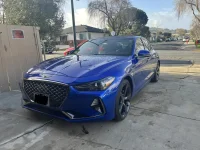I have the stock 18s and don't plan an upgrade. 45 sidewall is pretty much the lowest I'll go for the reasons you mentioned. I'll need to replace the OEM 225/45/18 Michelins AS tires soon. So likely go with 235/45/18.. A tad wider and slightly taller. I suppose I could go much wider and do a 245/40/18 - would the wider tire offset the lower profile and even out the ride comfort equation?
Typically, the wider the tire, the contact patch change from a long oval to a wide oval. This means:
1. Tire makes noise when the tread element strikes the pavement. It cannot make noise when it stay in full contact with the road surface; neither can it make noise after it leaves road contact and is just whirling around in the air.
2. The wider oval the contact patch, the more tread elements strikes the pavement on each rotation, the more noise it can potentially generate.
3. The longer oval the contact patch, the less tread elements strikes the pavement on each rotation, and the longer the residence time the tread elements stays quietly in contact with the road surface.
Obviously, tread pattern/compound make a big difference, but all things being equal, wider tires tend to be louder.
That said, the
rim size a particular tire is mounted on, also make an NVH difference. I actually have a set of A/S 235/45R18 mounted on 18x8
Stinger OEM
rims, and another set of A/S 235/45R18 mounted on 18x7.5 old OEM Genesis sedan
rims. Now, they are different brand/model tires, so naturally they will behave differently, but the fact that the 18x7.5 set rides very noticeably smoother cannot be all be due to the different brand/model. Narrow
rims tend to allow the tire sidewall to be more compliant... that is, more able to flex and yield to the various forces acted upon the tire - be it lateral forces while cornering, or compression forces due to hitting road irregularities. This is, of course, good for ride quality, but it does compromise on steering sharpness. For everyday commuting and street driving, I much prefer having a good amount of tire compliance. For track, it'd typically be the opposite.
Also, the shorter the tire sidewall, the less the NVH generated by the tire tread striking the pavement gets attenuated by the rubber sidewall, therefore more of that NVH gets transmitted up through the
wheel and the suspension into the cabin.
So, everything is a compromise.
So far, based on my experiences, I'd say on the stock 18x8, 235/45R18 works well, if the emphasis is on ride quality. Handling remains excellent though. BTW, excellent winter tire size. For better all-around street performance in warmer weather, 255/40R18 would be an excellent choice, particularly for the 3.3T. Just know that road noise will be a tad higher, especially after the tires have worn some. 245 would also work, but that size is kinda stuck in the middle. 245/45R18 has a rolling diameter that is a bit too large compared to the stock 225/45R18, while 245/40R18's rolling diameter would be a bit smaller. They will still work just fine, but your speedometer would be off either way. Some folks might not care.
For track, square 255/35R18 would be an excellent choice. That's what I'd be mounting on the 18x8.5s once the current 245/40R18 Ecsta V730 are toast later this year. The rolling diameter would be smaller than stock, but for track that's actually a plus. Ride height will be a tad lower, which is good, and it would give the car effectively a shorter final drive ratio, so slightly quicker accel in the lower gears. The short sidewall would yield excellent lateral stability and steering sharpness, while still maintaining adequate tire compliance for handling the rougher sections of the track.





 .
.





